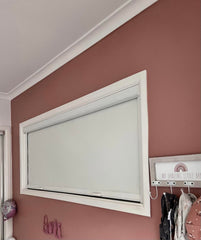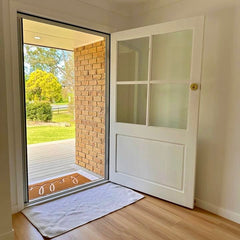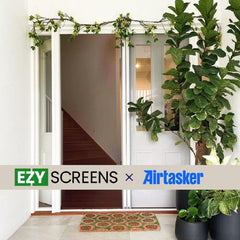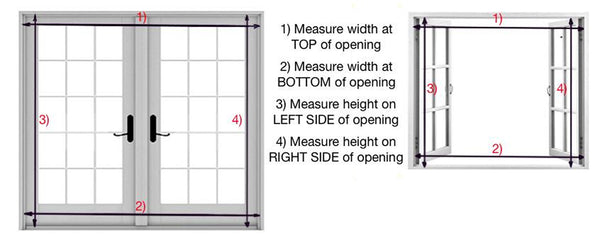Are Retractable Fly Screens Any Good?
Ever tried to enjoy a balmy summer evening with the doors wide open, only to be joined by a swarm of uninvited flying guests? You’re not alone. Australians love our indoor–outdoor lifestyle, but we’re also experts at swatting flies and dodging mozzies. That’s why retractable fly screens are becoming such a hot pick for modern homes.
They offer a flexible way to keep insects out while letting the breeze in, and they’re popping up everywhere from heritage terraces to contemporary apartments. But are retractable fly screens really as good as they seem?
What Are Retractable Fly Screens and How Do They Work?
Retractable fly screens are modern screens that roll or fold away into a slim cassette when you don’t need them. Unlike fixed screens, which are permanently in place, retractable screens vanish neatly out of sight, perfect for those who don’t want their views or home’s aesthetic compromised.
For example, this retractable single-door screen is a brilliant example of functional flexibility: it smoothly slides across your doorway when you want protection, and tucks away when you don’t. They typically operate on a spring-loaded or magnetic mechanism, with mesh that’s taut when extended but safely concealed when retracted.
Benefits of Choosing Retractable Fly Screens
Seamless Design and Aesthetic Appeal
One of the biggest drawcards of retractable screens is how well they blend into your home. The cassettes are slim and often colour-matched to your door or window frames, so you hardly notice they’re there.
They integrate beautifully with contemporary or classic designs, making them perfect for those who care about the details. Whether you’ve got floor-to-ceiling bifolds or a charming French door, a retractable screen keeps the look clean and modern.
Ease of Use and Functionality
Thanks to their clever mechanisms, retractable fly screens are incredibly easy to use. With a gentle pull, the screen glides across and locks into place. Some models even come with soft-closing features so they retract smoothly and quietly.
These screens are ideal for entry doors, patios, or balcony access where you don’t want a fixed barrier in the way. When you don’t need it, simply let it roll back into its housing.
Improved Ventilation Without Bugs
Australians are champions of fresh air, and retractable screens make it easy to keep air flowing through your home while keeping pests out. Unlike glass doors or closed windows, these screens let you enjoy the breeze without worrying about flies, mozzies, or larger insects sneaking in.
You get to enjoy a cooler, more comfortable living space without the need for chemical sprays or noisy zappers.
Common Limitations to Consider
Higher Cost Compared to Fixed Screens
The biggest downside? They’re more expensive upfront than fixed screens. Retractable screens require more engineering, and their materials and mechanisms add to the cost.
However, many homeowners feel the value is worth it. You’re paying for aesthetics, flexibility, and convenience. For high-traffic areas or design-conscious homes, that initial investment often pays itself off in enjoyment and practicality.
Maintenance Requirements
Because retractable screens have moving parts and the mesh rolls away, they need a little more TLC than fixed screens. Dust and debris can build up in the tracks, and over time, the spring or tension mechanism may need adjusting.
Giving the mesh and frame an occasional clean and checking for snags can keep your screen looking and functioning like new.
May Not Suit All Windows
Retractable screens are great for standard doors and large openings, but they may not work on every window type. For tricky configurations, a retractable window fly screen might still be an option, but it’s worth checking the dimensions and mechanisms before buying.
Retractable vs Fixed Screens: Which Is Right for You?
So which is better: retractable or fixed screens?
If you appreciate clean lines, flexibility, and unobstructed views when screens aren’t needed, retractable wins hands down. They’re ideal for stylish homes, entertaining areas, or where you want the option to open up your space completely.
On the other hand, fixed screens are cheaper, lower-maintenance, and perfectly fine if you’re happy to have the mesh permanently in place. Installation is usually simpler and quicker too.
Ultimately, it comes down to your budget, priorities, and how much you care about aesthetics and convenience.
What to Look for When Buying
Frame Materials and Mesh Types
Not all retractable screens are created equal. Look for sturdy, corrosion-resistant frames. Aluminium is a great choice for longevity and style.
For mesh, you can opt for standard fibreglass, or go for stronger, pet-resistant mesh if you’ve got furry family members who love scratching or leaning on the screens. The quality of both the frame and mesh will dictate how well your screen performs over time.
Warranty and Installation Options
Always check the warranty. A good manufacturer will stand behind their product with a decent guarantee on both parts and workmanship. While some screens are DIY-friendly, professional installation ensures a perfect fit, especially on larger or more complex openings.
Customer Experiences and Case Studies
Plenty of Aussie households have embraced retractable screens and swear by them. Many install them on bifold doors to enjoy an open patio during summer without compromising the look of their home, appreciating how easily the screens slide away when not needed. Others have added a single-door retractable screen to a balcony or small apartment entrance, often finding it quick to install and a huge improvement for keeping mozzies out while dining or relaxing.
Final Thoughts: Are They Worth It?
For anyone who loves open-air living without compromising on looks or convenience, retractable fly screens are a fantastic choice.
They’re especially suited to modern homes, entertaining spaces, or anywhere you want both airflow and flexibility. While they cost more upfront and need a little care, the payoff in comfort, style, and usability is hard to beat.
FAQs
Do retractable fly screens actually keep insects out effectively?
Yes, they’re designed to form a tight seal that blocks flies, mozzies, and other insects when closed properly.
How long do retractable fly screens last?
With good care, they can last 5–10 years, depending on build quality and exposure to weather.
Can I install retractable fly screens myself?
Some models are DIY-friendly, but for best fit and performance, professional installation is recommended.
Are they suitable for windy areas?
Most quality screens can handle moderate wind, but in high-wind zones, retracting them when not in use is advised.







